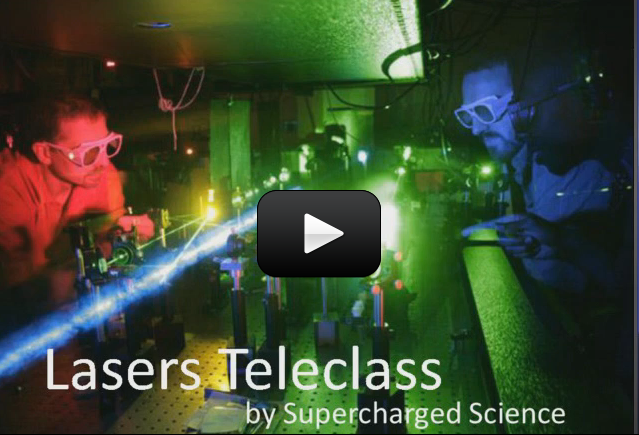This is a recording of a recent live teleclass I did with thousands of kids from all over the world. I've included it here so you can participate and learn, too!
This class is all about Light Waves! Energy can take one of two forms: matter and light (called electromagnetic radiation). Light is energy in the form of either a particle or a wave that can travel through space and some kinds of matter, like glass.
We're going to investigate the wild world of the photon that has baffled scientists for over a century. We'll also do experiments in shattering laser beams, bending and twisting light, and also split light waves into rainbow shadows. Materials:
This class is all about Light Waves! Energy can take one of two forms: matter and light (called electromagnetic radiation). Light is energy in the form of either a particle or a wave that can travel through space and some kinds of matter, like glass.
We're going to investigate the wild world of the photon that has baffled scientists for over a century. We'll also do experiments in shattering laser beams, bending and twisting light, and also split light waves into rainbow shadows. Materials:
- laser pointer
- flashlight
- paper clip
- gummy bear (green and red)
- old CD
- paper clip
- rubber band
- pond water (just a little bit)


Atoms are too small to see with your eyes, even with a microscope! Atoms themselves do not have different colors (they are clear except under special conditions). Even if you could see the individual atom by itself, it would be way too faint to detect a color.
are atoms different colors?
Oh, no! I am so sorry about that… I’ll get that updated now. You will use those materials also, just later in the section.
I noticed the list of materials are different from the ones outlined in the video. Good thing I checked before I went out to spend extra money!
Which teleclass are you looking for? You should have access to all of them!
Do we have access to the live telecast above? We are doing the light and lazer optics lessons and wondered. Thank you!
Connie Dudley
It depends on your laser (cheaper ones will diffuse the beam out over a given length) and the mirror itself (use front surface mirrors for best results). Most mirrors are back-surface, so the beam has to travel through glass first before it gets reflected, and then it has to go back through the glass again before getting back into the air, which causes losses in the light.
To answer your question, I am trying to do an experiment with lasers and mirrors and also how far a laser can bounce off a mirror in one strait line.
Hmm… what are you looking to do exactly?
Hi, Aroura this is Andie, I have a question for summer e-camp laser lab. Is there a boundery on how far a laser can reflect of an inch long square mirror?
You’re asking two different questions, actually. Are you more wanting to know how light enters your eye and working with the brain to create an image, or why do objects appear the color they are, like a apple being red, the couch being green…?
How does your eye pick up the light around you, like how do you know the couch is green, and stuff like that.
I am not sure which experiment you are referring to. Can you explain a little more or provide the experiment name or url?
for the defracting light expirement does it have to be a green laser because the red one is not working
Flashlights with pictures? I am not quite sure what you mean. Send me a photo or description?
do flashlights with pictures work?